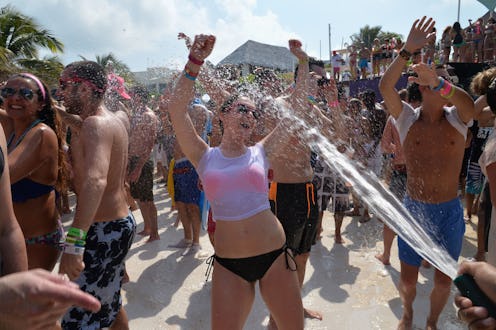Life
5 Things You Didn't Know About Spring Break
Come this year's spring (and yes, now that it's March, it really is coming!), hundreds of thousands of American college students (and some ex-students who just want to hang onto their former glory) will be headed for wild party spots down south and across the border, for a bacchanal frenzy of non-stop partying, neon sunglasses, and near-impossible levels of alcohol consumption. But the modern excesses of spring break haven't always been set in stone. What we know today as an intense period of completely limit-free fun in the sun actually began fairly innocently, with young, well-tanned men and women coming to Fort Lauderdale, Florida, to train with their swimming teams. So how did it get to its current state?
The history of spring break is equal parts charming, weird, and an interesting reflection on the power of media culture. It's had several stages of evolution, from clean-cut athletic event to swinging '60s cultural haven to '80s legal woes. So if you're heading off with your friends this year for some spring break fun, give a nod to five aspects of its odd past: if history continues at this pace, it's probably only going to get wilder.
1. Celebrating spring with massive partying is a tradition that's over 2,000 years old.
The bikinis and beer bongs might be new, but the idea of celebrating spring by going mental and losing all your inhibitions is a firm part of many cultures' history. The ancient Romans had a festival called Floralia, which lasted from April 28 to May 3 and was completely insane: there are reports of prostitutes having mock gladiator fights, an elephant performing on a tightrope, and what the Emperor Augustus vaguely called "unseemly debauchery".
It wasn't just the Romans, though. The Celts danced around bonfires for Beltane, and the English went "a-maying," which was technically meant to be gathering greenery and flowers to "bring in the may," but was more practically — as we learn in Robert Herrick's famous poem trying to persuade his girlfriend to go a-maying with him — a time for people to have sex in hedges. So much has changed, am I right?
2. Modern spring break all began with toothpaste, a hurricane, and a swimming team.
Back in 1926, Miami was completely flattened by a hurricane — but the destroyed city of Fort Lauderdale decided to take those lemons and make lemonade. In the ruins, it built the first Olympic-sized pool in Florida, the Casino Swimming Pool, and spread the word among colleges all over the U.S/: here was a place to bring your teams to train during school breaks.
The first team to show up came from Colgate University — yes, as in the toothpaste Colgate, who were a real family and on the university's board. Their all-male squad came down from New York, and loved it. The Casino became the site of a yearly spring swim meet, with colleges sending teams from all over the country. Predictably, a reputation for partying started.
3. A professor's novel heralded spring break's breakthrough.
The splendidly-named college professor Glendon Swarthout, intrigued by his pupils' rapturous stories of their Florida-based spring parties, decided to venture forth and investigate for himself in 1958. He wrote a novel about the experience, Where The Boys Are, about college co-eds looking for love at spring break — and Hollywood picked it up and made it into a hit film, starring George Hamilton.
The effect was immediate: spring break became a craze, the film's soundtrack by Connie Francis was its anthem, and 50,000 people flocked to Fort Lauderdale after the film was released. The big-time spring break mayhem had begun.
4. Spring break as we know it is a product of MTV.
In case you haven't heard, or lacked a TV growing up, MTV basically created Spring Break's modern cult reputation. It sensed the growing market and hosted its first live spring break concert at Daytona Beach, Florida, in 1986. All that followed — major advertisers, bands flocking to play to huge crowds, Girls Gone Wild, the invention of the wet T-shirt contest (yes, that originated at spring break) — was pushed and documented by MTV. It was one of the first cases of youth culture being basically mass-marketed, and it worked. Perhaps too well.
5. Fort Lauderdale effectively banned spring break in the 1980s.
From its small and refined beginnings, Fort Lauderdale's spring break had ballooned, and by the late 1980s — and an historic 350,000 breakers causing chaos — the city was sick of it. They began to force Spring Breakers elsewhere, by raising the drinking age, conducting mass arrests, making open containers illegal and erecting a wall on its own beach. It was successful: people in search of fun went first to other places in Florida, then further afield, to resorts like Cancun, Punta Cana, and Puerto Vallarta.
Images: Fort Lauderdale Historical Society, Cinemascope, Wikimedia Commons, Giphy
